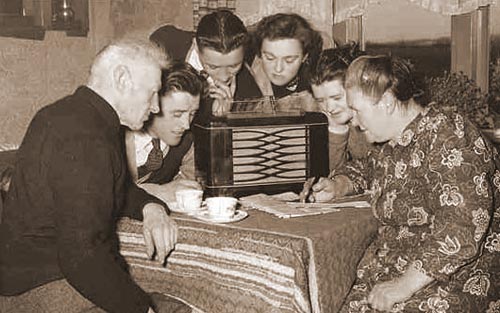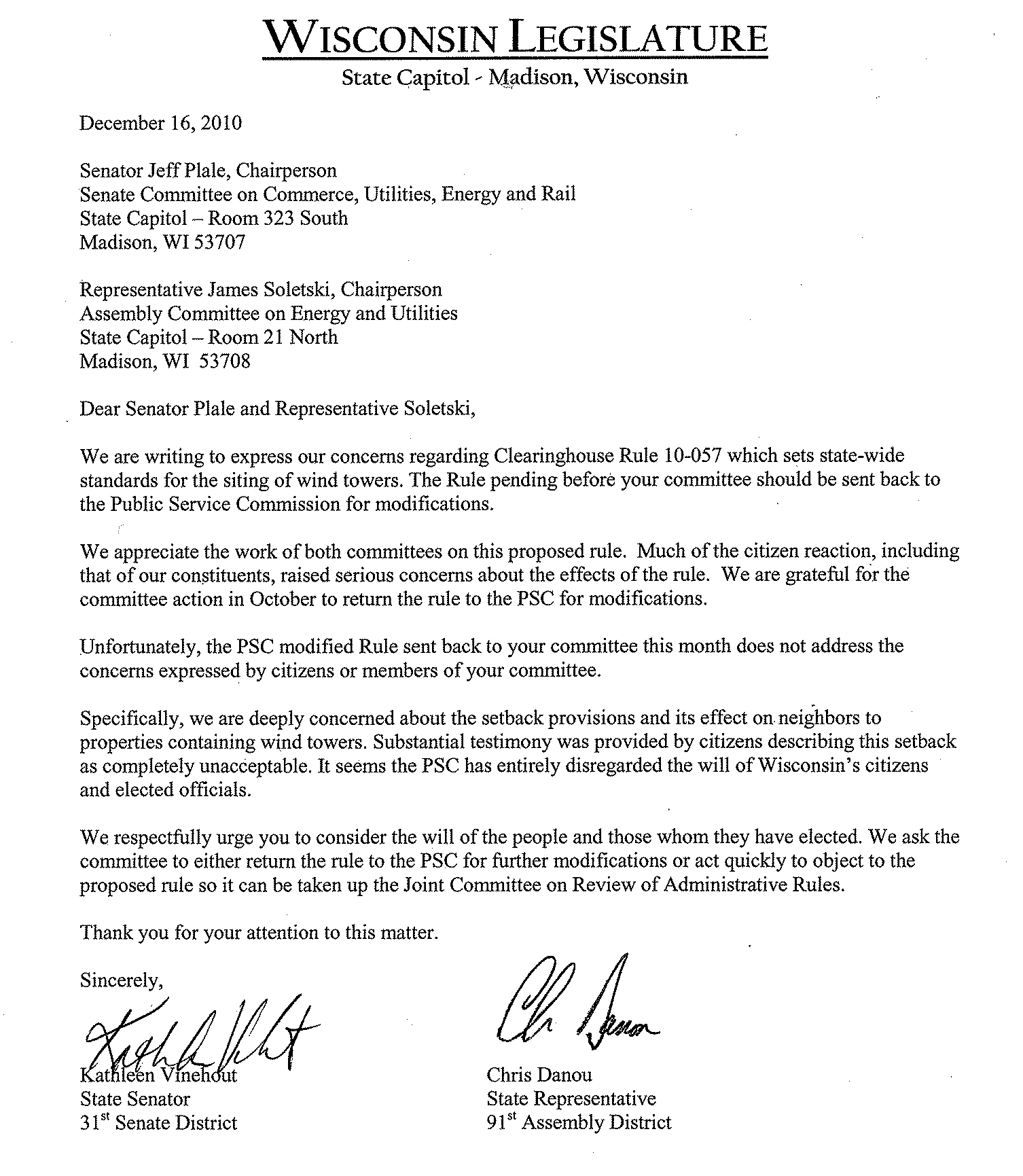Entries in wind farm wild life (41)
3/31/11 Local elections tied to wind development in Brown County AND Big wind lawsuit in little St. Croix county AND Wind Whirl over cancelled projects: How much of it is spin? AND Wind blade factory falls through: carrot on end of stick could have been a mirage AND Hello Windmill, Bye Bye Birdie
WIND FARMS REMAIN AN ISSUE IN GLENMORE, MORRISON
Source: Green Bay Press Gazette
March 31, 2011
By Doug Schneider
Wind farms remain a campaign issue in two southern Brown County towns, despite a company's recent decision to cancel plans for 100 wind turbines in Morrison, Glenmore and other nearby communities.
Invenergy LLC said it would not pursue permits for a wind farm in the area, but campaign signs related to wind energy continue to dot the landscape, and candidates say they still need to be prepared with future proposals that could affect residents' quality of life.
"We have to keep in mind that there are other projects like this out there, smaller developments," said Todd Christensen, who is seeking re-election as Morrison town board chairman, "and there could be more in the future."
Invenergy would have put 54 turbines in Morrison, four in Glenmore, and others in Wrightstown and Holland. Because some town officials expect there will be other developments proposed, towns are banding together to push for consistent regulations on issues related to windmills, and are asking state officials to consider their concerns. A handful of wind turbines were built as part of another project off Wisconsin 96 near the hamlet of Shirley.
But candidates also say there are issues beyond wind-energy regulation.
Cliff Hammond, who is challenging Christensen, said the next town board also will need to work to maintain a balanced budget as financial support from the state and county decline.
Kriss Schmidt, who is running for board chairperson in Glenmore, said board members will have to make sure basic services like snowplowing and road-patching are maintained.
Pat Kolarik, who also is running for Glenmore board chair, said the key for elected officials will be to focus on maintaining residents' quality of life whether the issue is wind energy or something else.
"There are going to be a number of challenges we have to address — budget, services, appropriate setbacks for any structure," she said. "The goal for me would be to work with residents on appropriate solutions."
ENERGY SOLUTION OR LEGAL TROUBLE?
March 31 2011
"The controversial energy project in Forest has come under fire and may be stopped by a federal lawsuit which was filed by a citizens’ group in February."
A legal battle in northeastern St. Croix County highlights the difficult issues of wind-generated power. Talk to anyone and they will, in general terms, talk about wind power as a good, efficient and cheap energy source for the times — be it today or tomorrow.
Try finding a location to construct wind generators and suddenly you’ve got yourself a first-class controversy, complete with arguments among neighbors, recalls and lawsuits.
Such is the case in St. Croix County in the town of Forest.
The controversial energy project in Forest has come under fire and may be stopped by a federal lawsuit which was filed by a citizens’ group in February. That suit was also supported by action of a new town board that was elected through a successful recall election. The former board had approved the proposed wind energy project last summer.
A citizens’ lawsuit was filed in February. In March, the new town of Forest board voted to rescind a wind energy development agreement and other approvals that had been granted to a wind developer. The project, being proposed by a private developer named Emerging Energies, is in jeopardy.
The project in Forest called for 39 wind towers. Each tower stands about 500 feet tall.
Many landowners in the town had signed leases with the wind firm, but were prohibited from discussing the project. When the rest of the town’s residents got “wind” of the deals, the uprising began.
Now there are battles over setbacks, noise, quality of life, health, property value, safety and more. Emerging Energies, LLC, has also threat-ened the new town board with legal action.
A similar scenario developed in the eastern part of the state when a Chicago wind energy developer, Invenergy LLC, dropped its plan to build a large wind farm near Green Bay.
Opponents in the Green Bay area are expressing the same concerns and claim they will continue to work to prevent the “irresponsible development of industrial wind projects.”
State energy regulators are now trying to come up with a plan to help support wind projects. Regulators may be asked to go back to the drawing board to develop statewide rules governing wind power projects, under a bill to be considered this week.
The Legislature’s joint committee for review of administrative rules voted earlier this month to temporarily block a wind farm site rule developed by the state Public Service Commission.
Supporters of wind energy development say legal problems will stall development, leading to a loss of jobs tied to wind turbine construction as well as revenue for host property owners and local governments. There seems to be plenty of controversy over, among other things, setbacks for wind towers.
A property rights bill introduced by Gov. Scott Walker in January would restrict wind towers from being placed less than 1,800 feet from a property line. That bill had the apparent support of wind farm opponents and the Wisconsin Realtors Association.
In its most recent wind farm decision, the PSC ruled that 1,250-foot setbacks be required for We Energies’ Glacier Hills Wind Park, now under construction in Columbia County.
The bottom line is, when wind towers begin popping up in either populated areas, or rural countryside, there is likely to be plenty of opposition. A group of wind towers doesn’t do much for the scenic value of any topography.
Despite all the virtues of wind power, developing a power source to a degree where it would have a significant impact could be difficult when facing “not in my backyard” neighborhoods.
MIDWEST WIND SUSPENDS DEVELOPMENT WORK IN STATE
"Wind industry representatives said the PSC rule was restrictive because it set specific decibel limits for turbine noise and shadow flicker restrictions as well as setbacks."
March 31, 2011
By Thomas Content
Midwest Wind Energy is suspending development of two wind farms in Wisconsin, the Illinois company said Wednesday.
The company developed the Butler Ridge wind farm in Dodge County and the Cedar Ridge project in Fond du Lac County, projects now owned and operated by other companies.
Midwest Wind said it was actively working on a 98-megawatt wind farm in Calumet County and another project for which a location had not yet been announced.
Midwest Wind cited development opportunities in other states at a time when Wisconsin policymakers are moving to restrict wind farm development.
"Most states are clearly open for renewable energy development and the economic development dollars and jobs that come with it,” said Stefan Noe, company president. “So long as there are states rolling out the welcome mat it doesn't make sense to devote significant dollars to a state that is creating unreasonable roadblocks for wind development."
The action came one week after Invenergy of Chicago canceled plans to develop a large wind farm near Green Bay, and one day after a legislative committee voted to introduce a bill sending wind siting rules back to the state Public Service Commission for more work.
Republican lawmakers and Gov. Scott Walker have said the PSC rule allowed turbines to be built too close to nearby homes. Wind industry representatives said the PSC rule was restrictive because it set specific decibel limits for turbine noise and shadow flicker restrictions as well as setbacks.
A bill that passed in the Legislature two years ago called on the PSC to set up a uniform standard for wind projects across the state, to replace a patchwork of local rules and moratoriums that were in place with regard to wind projects.
Keith Reopelle, senior policy director at the environmental group Clean Wisconsin, said the new chair of the PSC, Phil Montgomery, was a co-sponsor and supporter of the bill that called on the PSC to set statewide standards. He said he hoped the agency would move quickly to develop a workable set of rules.
When the bill was introduced in 2009, Montgomery – then a state lawmaker from Brown County and ranking Republican on the Assembly energy and utilities committee - released a statement in support of a uniform state standard.
“Wind power is job-creating power,” Montgomery said in April 2009. “A fair and uniform state standard for siting wind developments will create an environment of investment in our state while moving us closer to our green energy goals.”
WIND TURBINE PLANT ON HOLD
Source: Wisconsin Rapids Daily Tribune
March 31, 2011
By Nathaniel Shuda
"I think we had to give them every opportunity to succeed," council member Lee Albrecht said. "You have this carrot dangling out there that there are 600 jobs on the horizon; I think you have to do whatever you can to have that carrot come to you."
Wisconsin Rapids is ready to buy back land it sold to a local company that two years ago announced plans to build a wind-turbine blade manufacturing plant on the property.
Energy Composites Corp. faces a Friday deadline to either reach an agreement with Wisconsin Rapids or sell the nearly 94 acres of land back to the city at the original purchasing price, Mayor Mary Jo Carson said.
Carson said the sale doesn't necessarily mean the project is dead, but it won't happen right now.
"Obviously, ECC doesn't want to hold us up in reference to that land, which we thank them for," she said. "We appreciate their interest in their hometown."
Carson said City Attorney Sue Schill has been working with the company's attorney to reach a buy-back agreement.
On March 31, 2009, the company announced plans to build a 350,000-square-foot plant in the Rapids East Commerce Center that would create at least 400 local jobs. Since then, those plans expanded to 535,000 square feet and more than 600 positions.
To facilitate the project, the city later sold the Wisconsin Rapids-based company 93.7 acres of land in the Rapids East Commerce Center for $500 an acre -- a 90 percent discount from the typical asking price -- plus a $1,000 option fee, for a total price of $47,850.
Under the pending agreement, the city would buy back the land at the same price for which it sold it, Carson said.
"I'm glad to see it being sold back to the city at the original price," City Council member Marion Hokamp said. "The sooner they do it, the better it's going to be. Maybe we're going to get somebody else interested (in the property)."
As part of the original development agreement, the city would have paid $1.5 million for infrastructure costs, including extending city streets and expanding railroad access to the property, and $6,000 for each full-time job the company created on or before Dec. 31, 2012, up to $3.8 million.
At this point, Wisconsin Rapids has not invested any money in the project, city Finance Director Tim Desorcy said.
A decline in bond market conditions led company officials to put the project on hold while they searched for investors. Those efforts have been unsuccessful.
Hokamp, who has publicly criticized Energy Composites for a lack of action, said the city should have bought the property back sooner. She remained skeptical of the project throughout the process.
"Way back when they started, I never thought it was going to be done," she said. "They knew they weren't going to have anything out there a long time ago."
Other council members do not regret giving the company so long to bring the plan to fruition.
"I think we had to give them every opportunity to succeed," council member Lee Albrecht said. "You have this carrot dangling out there that there are 600 jobs on the horizon; I think you have to do whatever you can to have that carrot come to you."
WIND FARMS THREATEN MANY BIRD SPECIES WITH EXTINCTION
SOURCE Save The Eagles Foundation
STEI's president, Mark Duchamp, objects to the wind industry comparing bird mortality at windfarms to that from other causes related to human activities. These other threats have already reduced bird populations worldwide, he said, and are continuing to do so.
"But mortality caused by windfarms and their power lines is new and additional", he adds, "and like the proverbial last drop that spills the glass, its effects will be upsetting.
To wit the Tasmanian Wedge-tailed Eagle, which has been condemned to extinction by the construction of 7 windfarms in its habitat" (1).
Another important difference, says Duchamp, is that the other threats can't be easily stopped, whereas poorly-sited windfarm projects can. The Spanish Ornithological Society (SEO/Birdlife) recommended this month that windfarms no longer be built in natural areas, but in urban and industrial areas instead (2).
One week later, SEO/Birdlife revealed that bird mortality caused by windfarms and power lines was much higher than previously thought. For the Spanish region of Castilla La Mancha, they estimate it to be "1.3 million birds a year, many of them in danger of extinction like the Imperial Eagle, the Bonelli´s Eagle or the Lesser Kestrel". And they added: "(this is) a considerable number which proves that windfarms have a great capacity for killing birds". (3)
"This is what I have been claiming for 9 years", says Duchamp, "but only this month did SEO recognize the danger. During all that time I have been treated as a heretic, and was banned from ornithology forums where my whistle-blowing was causing discomfort in the profession."
The French naturalist, who lives in Spain, has been vindicated at last. He praises the American Bird Conservancy, Birdlife Bulgaria, and SEO for their firm stand against improperly sited windfarms, but laments that it will take more years before the most prominent bird societies do likewise. Conflicts of interests are at the root of the problem, he says.
STEI warns that, if we are to save our emblematic bird species from this new threat, it is urgent to impose a moratorium on windfarm construction and to call for a really independent commission to investigate the whole windfarm matter, starting with the effectiveness of this intermittent, unreliable, and ruinous form of energy.
Duchamp founded Save the Eagles International in 2009, to raise awareness and to publish inconvenient bird mortality statistics that most bird societies fail to make available to the public. He has launched today the STEI website where these numbers and their sources can be found:
REFERENCES
(1) - Wind farms: suspicious error by consultant condemns Tasmanian eagle to extinction.
(2) - SEO Birdlife: " Castilla-La Mancha "debe abandonar el viejo modelo de grandes centrales de generación eléctrica situadas en plena naturaleza y alejadas de los puntos de consumo y fomentar la generación eléctrica en suelo urbano e industrial".
Translation: "Castilla-La Mancha "must abandon the old model of large power plants located in natural habitats, far away from where the energy is consumed, and promote electrical generation in urban and industrial zones."
(3) - SEO Birdlife: "1,3 millones de aves al año... un número considerable con el que se demuestra que los parques eólicos tienen «una gran capacidad para matar aves»."
Translation: "1.3 millon birds a year... a considerable number which proves that windfarms have a great capacity for killing birds "
3/1/11 UPDATE 3:23PM: PSC WIND RULES SUSPENDED AND Packers Fan or Bears Fan, when it comes to living with turbines they are telling the same story AND 2 out of 3 PSC commissioners side with We Energies Fat Cats AND What do you mean three hours of sleep a night isn't enough? AND How green is a bird killing machine? Chapter 234
From the Joint Committee for the Review of Administrative Rules:(Emphasis ours)
Motion onCh. PSC 128
That the Joint Committee for Review of Administrative Rules suspend Ch. PSC 128, pursuant to s. 227.26 (2) (d), Stats., effective March 1, 2011, on the basis of testimony received at its February 9, 2011 meeting, and on the grounds that the contents of Ch. PSC 128 create an emergency relating to public health, safety, or welfare; are arbitrary and capricious; and impose an undue hardship on landowners and residents adjacent to wind turbine sites as stated in s. 227.19 (4) (d) 2 and 6.
COMMITTEE VOTES TO SUSPEND WIND-SITING RULES
SOURCE: WisBusiness.com
March 1, 2011
By Andy Szal
The Joint Committee for Review of Administrative Rules this morning voted to suspend wind turbine siting regs that were set to take effect today.
The committee voted 5-2 along party lines to suspend PSC rule 128 and now has 30 days to submit a bill repealing the measure to the full Legislature.
Rep. Gary Hebl, D-Sun Prairie, accused the majority of going around the normal legislative process and flip-flopping, since a number of Republicans supported the wind siting bill last session.
"This wasn't a flash in the pan, fly by night rule," Hebl said.
Sen. Leah Vukmir, R-Wauwatosa and the committee co-chair, said the committee had a duty to reconsider the PSC rule after lawmakers voiced concerns about the issue early in the new session. Rep. Dan LeMahieu, R-Cascade, added, "We didn't vote for the rule. We voted to give them the authority to promulgate a rule."
Rep. Fred Kessler, D-Milwaukee, said the bill would have a particularly detrimental effect on the wind turbine industry in Manitowoc.
"These jobs probably will go to other states," Kessler said.
SECOND FEATURE: Different state, same story: The trouble with wind turbines sited too close to homes. Above, shadow flicker in the home of an Illinois family, below stories from more families having trouble.
WIND FARM COMPLAINTS
March 1, 2011
"As the sun comes across the sky, it hits the turbine blades and causes this flicker," she said.
Nearby homeowners say it can go on for hours. "When it first happened, we felt there was something wrong with the electricity because it felt like every light was blinking,"said Barb Draper.
People crowded a meeting in Princeton, Illinois Monday night to express their concerns about wind farms. Residents packed into a meeting with the Bureau County Board of Appeals. Some want to put a stop to the proposed Walnut Ridge wind project. It would build 150 turbines over more than 15,000 acres and affect more than 75 landowners.
Others at the meeting are already surrounded by wind turbines from the Big Sky wind farm. They want the county and the companies to focus on issues caused by the current turbines. They complain that the turbines are noisy, cast flickering shadows that can cause seizures and even block television reception.
The Anderson family in rural Ohio, Illinois says it has turned their quality of life and turned it into living in an industrial park. THe nearest wind turbine is 1,750 feet from their home. Deb Anderson says ever since the turbines started running, their life hasn't been the same.
"As the sun comes across the sky, it hits the turbine blades and causes this flicker," she said.
Nearby homeowners say it can go on for hours. "When it first happened, we felt there was something wrong with the electricity because it felt like every light was blinking,"said Barb Draper.
"On, off, on, off as the blade caught the sun it made a very disturbing motion. It almost made you sick to your stomach." added Bob Draper.
Another problem that came up after the turbines were turned on is with their TV reception. The family says it varies, depending on the direction of the blades. Some days, the family gets 15-20 channels. During our visit, they could only get in two.
On top of that there's the noise that won't go away. These property owners say they understand the benefits of the wind farms. But they'd like the problems fixed before more wind turbines come into the area.
The wind power company has put up two antennas on their house, but the family says they didn't help. They company also offered them money to buy a better delivery system, like satellite TV.
Ryan Light in the Director of Renewable Energy for the Eastern Iowa Community College District. He says those are some of the drawbacks for people living near large wind farms.
"One effect we need to look at a little harder into is the flicker effect, which is the spinning of blades and shadow cast. For people with certain medical concerns it can cause seizures," Light said.
He says there are companies working to alleviate the radio interference with a new kind of blade and there is more research being conducted on noise reduction systems.
SPLIT DECISION FINDS WE ENERGIES DIDN'T EARN TOO MUCH
SOURCE: Milwaukee Journal Sentinel
March 1, 2011
By Thomas Content
In a 2-to-1 vote, state regulators ruled Thursday that We Energies won’t have to issue credits to its 1.1 million electricity customers for profit it earned in 2008 and 2009.
Commissioner Lauren Azar sided with customer groups that had called for the commission to vote to return money to customers, saying the commission should decided that the utility earned more than its maximum profit allowed the regulated utility – 10.75% in 2008 and 2009.
But commissioners Eric Callisto and Mark Meyer voted not to require any profits to be returned to customers. Meyer said it was inconsistent for the commission to be seeking to return profits to customers when a utility earns above its maximum profit level since the commission does not allow utilities to raise rates when utilities fail to earn as much in a given year as the profit level, or return on equity, set by the commission.
Over the past 10 years, utilities have more often earned less than their return on equity, Meyer said.
The debate at Thursday's meeting ended up boiling down to how Callisto and Azar interpreted whether management bonuses paid to utility executives should be included in the calculation of a utility’s profit.
Callisto said the commission specifically excludes management bonuses and incentive pay from being collected in utility rates and that the commission staff will be conducting an investigation of utility bonuses in upcoming rate cases.
He said his position in this case was consistent with how the commission interpreted the issue in setting new rules for how utilities can raise rates when fuel prices climb.
Azar, who wanted the issue of bonuses addressed in the new fuel rules last year, said she has not changed her view. She said she considered utility bonuses too high for a regulated utility, given the state of the economy, high poverty rates in the We Energies service territory. The utility's "shareholders are doing quite well," she said.
In filings with the commission, We Energies had argued that the commission was shifting from utility regulator to utility micro-manager if it adopted the proposal of Azar and customer groups. The utility also argued that the commission has not had a consistent definition for utilities to determine what would and would not be included in a PSC calculation of whether a utility earned too much profit.
Callisto agreed. The issue came up in one prior case – in which the commission also ruled in We Energies’ favor – but the commission’s guidance to utilities on this issue has been “ephemeral.”
An analysis by We Energies prepared last week indicated that the utility could have been required to return $53 million to customers. Based on the majority decision Thursday, the commission determined that the utility earned profit of 10.36% in 2008 and 10.52% in 2009, below the 10.75% profit allowed by the PSC.
That means the utility $25.7 million less than the maximum, according to the filing.
Third Feature
FALMOUTH OFFERS PARTIAL TURBINE SHUTDOWN
SOURCE: Cape Cod Times, www.capecodonline.com
March 1, 2011
By Aaron Gouveia,
FALMOUTH — Falmouth officials have offered to turn off the town’s wind turbine for three hours a day, following noise complaints from neighbors.
Acting Town Manager Heather Harper proposed the partial overnight shutdown, calling the offer a “good faith effort toward a mutual resolution of the matter.”
After tracking complaints regarding the 1.65-megawatt turbine off Blacksmith Shop Road, known as Wind I, town officials found residents are most affected during periods of high winds in the late evening and early morning hours, Harper wrote in a Feb. 23 letter.
“We intend to modify the operation of the machine between the hours of midnight and 3 a.m., the times at which the background noise may be lower than the sound emanating from our wind energy equipment,” Harper wrote.
Details of the town’s offer are still unclear, however. Harper’s letter did not specify whether the turbine would be turned off for three hours every night or only during periods of high winds.
When approached by a Times reporter prior to Monday’s selectmen’s meeting, Harper said she did not know the answer and was unable to provide one before the start of the meeting. The meeting was still in progress as of the Times’ deadline.
But Gerald Potamis, the town’s wastewater superintendent who oversees operation of Wind I, said the change will go into effect as soon as the turbine manufacturer, Vestas, sends a technician to reprogram the turbine.
The shutdown is an “interim solution” until town officials and neighbors can work out a permanent solution, Potamis said.
But Christopher Senie, an attorney representing 18 residents who claim they are adversely affected by turbine noise, vibrations and shadow flicker, has said the town’s offer is not good enough.
Senie, who was not available for comment Monday, penned a Feb. 25 letter that stated this is the second time in four months Harper has made the offer to his clients.
Senie called the three-hour reprieve “wholly inadequate” in his letter, and wrote the suffering of neighbors “will not be lessened in any meaningful way.”
The only acceptable interim solution, he wrote, is to shut off Wind I whenever wind speeds reach 23 mph. It is a proposal Harper has repeatedly rejected, according to Senie’s letter.
“This is the only meaningful way to provide my clients some relief while the ultimate solution is developed and implemented,” Senie wrote.
Todd Drummey, who lives approximately 3,000 feet from Wind I, said the town’s offer “completely misses the point” because it assumes residents will be satisfied with three hours of sleep every night.
“It’s the same offer from back in October,” Drummey said. “It was ridiculous then and it’s ridiculous now.”
The ultimate goal, according to Senie and his clients, is to convince the town it was wrong not to require a special permit before the turbine became operational.
Building Commissioner Eladio Gore deemed the turbine a municipal use, and cited zoning bylaws that exempt “all municipal uses” from the special permit process. Senie, on the other hand, cited another local bylaw specifically pertaining to windmills, that requires a special permit in all instances.
Last month, three members of the zoning board of appeals said Gore made a mistake in interpreting the bylaws. But the appeal failed because two ZBA members recused themselves, meaning a 4-0 vote was necessary to uphold the appeal.
But the neighbors are still hopeful because selectmen — acting as the owners of the turbine — can request a special permit at any time.
To that end, several neighbors showed up at Monday’s meeting hoping to persuade selectmen to start the special permit process, which will give neighbors a chance to negotiate some potential compromises. But they were not on the agenda, and as of 9:30 p.m. it was unclear whether they would be allowed to speak.
NEXT FEATURE:
WOLFE ISLAND WIND PLANT STILL HARMING BIRDS IN IMPORTANT BIRD AREA
SOURCE: Nature Canada, www.naturecanada.ca
Last May, Nature Canada’s Ted Cheskey blogged about a report that described how birds and bats have been affected by the TransAlta wind plant on Wolfe Island, a globally significant Important Bird Area in southern Ontario known for its waterfowl, raptors and swallows. He called the numbers of birds and bats being killed by TransAlta’s turbines “shockingly high,” indeed the highest recorded in Canada and one of the highest in North America.
However, since the report only studied a six month period, TransAlta’s spokespeople argued that it was premature to reach conclusions so soon, especially when comparing the Wolfe Island deaths to yearly casualty rates for other wind plants. Besides, TransAlta reasoned, the results appeared to be within the thresholds of acceptable limits set by provincial and federal government regulators.
Then last month, Stantec Consulting, the firm that produced the original report, released its report on the second half of the year: January 1, 2010 to July 1, 2010.
And the results for birds are troubling.
Wolfe Island: Most Deadly Wind Plant in Canada
Though casualty numbers for birds did not skyrocket in the second sixth month period, a time that included the spring migration, they still were high enough to make the Wolfe Island wind plant the most deadly for birds in Canada.
The 13.4 birds per turbine casualty rate is about 7 times the industry average in Canada according to Canadian Wind Energy Association (CANWEA) but below the so-called “adaptive management” threshold for TransAlta facility, as set by various government agencies. That level is 11.7 birds per MW which translates to 21 birds per turbine, which just happens to be the highest level ever recorded at any wind facility in North America (Buffalo Mountain, Tennessee). Using the highest level recorded as the threshold before which any mitigation is even considered seems a bit dubious to say the least.
Estimated and actual numbers of birds killed, proportioned by the species actually found, over the entire 12 month period, paints a disturbing picture:
- Tree Swallow 218 (calculation based on 31 corpses)
- Purple Martin 49 (calculation based on 7 corpses)
- Bobolink 73 (calculation based on 9 corpses)
- Wilson’s Snipe 50 (calculation based on 7 corpses)
- Red-tailed Hawk 10 (actual count)
It is important to note that the calculated numbers are arrived at using Stantec’s formula to calculate total casualty rates. A sample of turbines are visited either weekly or twice a week and a search for bird corpses on the ground beneath the blades is conducted. As the method is not intended as a comprehensive search, determining the casualty rate requires taking in factors like the ability of the search team to find carcasses, the percentage of the area searched and the rate of predation between searches. The 31 Tree Swallow corpses, in other words, represent about 15% of the calculated number of tree swallows killed, based on Stantec’s calculations and field testing.
Birds Most Effected are Already in Serious Decline
While the report and the research behind it appear to be quite solid, the authors contend that the casualty rates are quite sustainable and will not have any effect on the species populations. They do this by contrasting the kill numbers from the turbines with the estimated Ontario population of the most affected species – Tree Swallow, numbering about 400,000 and Bobolink, about 800,000. (They do not do this for Red-tailed Hawk, which in fact may not meet their sustainability criteria). They also contrasted the numbers with estimates of birds killed by other human activities or artifices such as tall buildings, vehicles, cell towers, and pets.
While this argument has gained considerable traction among some in the wind industry and even the scientific community, it fails to consider that the turbines at Wolfe Island are killing different species than the tall buildings, cats and cars. Tree Swallow, Purple Martin, Red-tailed Hawk, Turkey Vulture and Bobolink rarely if ever show up on lists of casualties from tall buildings, and are unlikely victims of cats, with the possible exception of the Bobolink. And vehicle collisions, well – while this is a legitimate concern, Turkey Vultures have arguably had a net benefit from the carnage caused by vehicles.
But it is some of these very species – the ones most likely to be harmed by Wolfe Island’s turbines – that are already experiencing declines.
Take swallows, for example. Most species of swallow have declined significantly in Canada over the past 20 years. Adding additional threats to already stressed populations is not prudent. According to trend data on this species from Breeding Bird Survey routes in Ontario, the Tree Swallow has declined by about 6% annually over the past 20 years, a cumulative decline of almost 80%! In other words, the current estimated population of 400,000, was 2 million only 20 years ago. Bobolink, recently added to COSEWIC’s list of threatened species, declined 4.1% over the same period. We should not trivialize the impact of removing dozens, or hundreds of individuals from a population of species that are clearly in trouble.
In the meantime, good documentation of the impacts is essential. While TransAlta had to deliver these studies – they were a condition of the wind project’s approval – the company and Stantec should be recognized for doing good work. Once one takes the spin out of the document, the data and the methodologies are solid. The quality of the monitoring appears to be high, and some weaknesses, such as a potential bias to undercount the number of raptor fatalities, are recognized in the report.
With regard to birds of prey, even if they were not undercounted, the number of casualties is excessively high at .27 per turbine. This was the highest recorded rate for raptor kills outside of California. The victims included:
- 10 Red-tailed Hawks,
- 1 Northern Harrier,
- 1 Osprey,
- 2 American Kestrel,
- 1 Merlin
- 8 Turkey Vulture
This number crossed the “notification threshold” for the project, meaning that the CWS and MNR were notified about the high rates. The report states that TransAlta and MNR have initiated discussions regarding “adaptive management” in response to the raptor deaths. We look forward to hearing what the response might be.
Next Steps to Reduce Bird Deaths
With the plant already in operation, the only option now is to mitigate the risk to wildlife perhaps by slowing down the blades of the turbines at hazardous moments of the year, or turning them off. However, unless the numbers of casualties increase even further in the next two years, it is unclear how far the threshold must be exceeded and how often, before mitigation is implemented. It is reported in the document that four notifications were made by the company to the government for raptors alone, yet none appears to have led to mitigation.
Today, several wind farms are being proposed around the eastern end of Lake Ontario, the most worrying being Gilead’s Ostrander Point wind farm. Ostrander Point is an area that is arguably even more significant for birds than Wolfe Island, because of its specific geography. Ironically, the land on which the Gilead project is being proposed is owned by the Province of Ontario – a Crown forest block.
Opposition to turbines in agricultural areas appears to have persuaded government officials to meet their renewable energy agenda by prioritizing “crown lands” as locations for wind energy plants. While this might be appropriate and acceptable for some properties, when a wind plant is located in an area of great significance to wildlife, as is the case with Ostrander Point, so-called green energy ceases to be green at all. The Ontario government needs to think more carefully about where they allow wind turbines. It is not too late for the Province to design a policy that promotes green energy and also protects key biodiversity sites including Important Bird Areas.
Otherwise, as more of these facilities are built in bad places, wind energy will become a significant contributor to the declines of several species that are already in trouble, and the Green Energy Act will be recognized and remembered for all of the wrong reasons.
Wolfe Island, located in the eastern end of Lake Ontario, a shore distance from Kingston, is about 32 kilometres long and about 11 wide in the widest area covering about 12,140 hectares. The west end of the island is exposed to the westerly winds blowing across much of the length of Lake Ontario. The island is a mixture of agricultural land under various regimes of management from annual crops to pasture, natural habitats from woodlands and patches of second-growth forest, to grasslands, wetlands and the residences and farms of the Wolfe Islanders. TransAlta’s 86 turbines tower 80 metres above the farmland, pasture, and grasslands, and are constructed largely on the western side of the islands where the winds are probably the strongest. The wind plant has a nameplate capacity of 198 Megawatts, but the average output in its first year of operation was only 48 Megawatts, a quarter of the capacity, due to the variability of winds. This output number appears to be about average for Ontario’s wind industry.
Wolfe Island is a Globally significant Important Bird Area, (IBA) recognized for its significance for waterfowl primarily, but also for its importance to raptors (birds of prey including hawks and owls) and Tree Swallows. Being at the eastern end of Lake Ontario, the island’s habitats are also important stop-over destinations for migrating birds and bats. Nature Canada believes that industrial wind plants should be excluded from IBAs, and other sites that are known to be highly significant for wildlife, particularly birds. No wind plant, even the notorious Altamont plant in California, has ever, to our knowledge been decommissioned because of impacts on wildlife. Once these things are built, then are not turned off until they stop working or break down. For us at Nature Canada, this a strong incentive to encourage provincial policies to exclude wind plants from IBAs and important migratory corridors and fight the few existing proposals within IBAs. However, the Wolfe Island plant is built and operating, so its impacts on birds and bats will be instructive for other projects being proposed or considered in areas that are significant for birds.
"On, off, on, off as the blade caught the sun it made a very disturbing motion. It almost made you sick to your stomach." added Bob Draper.
2/27/11 WINDKILL: How "Green" is a bird and bat killing machne? AND No matter what language you say it in, wind turbine shadow flicker is intolerable
[Note: Illustrations and photos on this post added by the BPWI Research Nerd]
WIND FARMS AND DEADLY SKIES: TURBINES ON TEXAS COAST KILLING THOUSANDS OF BIRDS AND BATS EACH YEAR
 SOURCE: San Antonio Express-News, www.mysanantonio.com
SOURCE: San Antonio Express-News, www.mysanantonio.com
February 27, 2011
By Colin McDonald,
SARITA — The 260-foot-tall wind turbines of the Kenedy Ranch stand like a steel forest along the edge of the Laguna Madre and pump out hundreds of megawatts of emission-free electricity.
The spinning blades, alongside some of the most important habitat in Texas and one of North America’s largest migratory flyways, are killing thousands of birds and bats each year.
How many isn’t publicly known because, unlike California counties, Texas and the federal government don’t require turbine operators to make public reports, according to state and federal officials.
Aside from the quantity of bird and bat deaths, a more complicated question remains unanswered as more wind turbines are put up along the Texas Coast: Have the turbines changed the ecosystem and displaced wildlife?
For the first time, Pattern Energy, which owns 118 turbines on the ranch, and Iberdrola Renewables, which owns 168, voluntarily released results of their first yearlong studies.
Pattern estimates up to 921 birds and 2,309 bats were killed between Aug. 24, 2009, and July 31; Iberdrola’s estimates: 1,812 birds and 3,087 bats for the same period.
While the bird killings match the national average, one researcher found the bat killings much higher than expected.
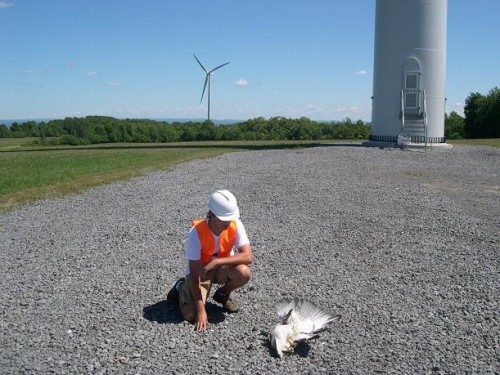 Those who opposed the wind farms are not convinced the studies are credible or conclusive.
Those who opposed the wind farms are not convinced the studies are credible or conclusive.
The work was paid for by the companies and not peer-reviewed. In their reports, biologists wrote about the challenges of collecting good data with rattlesnakes biting their search dogs and cows that would not leave. The researchers estimate scavengers removed half of the bird and bat carcasses before they could be found.
They also could not get federal permits to collect the species they did find, so many had to be marked as unknown.
After more than a year of submitting forms, the companies received a collection permit last month, said Rick Greiner of Pattern Energy.
But of the species identified, none were endangered.
“We think there is a low impact to T and E (threatened and endangered species) because we have not found any,” he said.
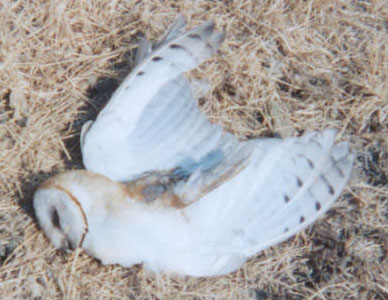
The reports state the wind farms had a bird mortality rate of three birds per megawatt, which is in the middle for the national average of one to six birds, according to the American Wind Energy Association, a trade group. A national average for bats killed per megawatt is not well-established.
In addition to average bird mortality, the companies point to the high-tech radar systems they voluntarily installed that will trigger a shutdown of the spinning turbines during fog or low visibility when a mass of birds or bats is approaching.
As of the end of 2010, a shutdown had not occurred.
“At every stage of the project’s life, Iberdrola Renewables has gone above and beyond what has been required by the state of Texas and federal government to conduct extensive studies and monitor the outcomes of our wildlife protection measures,” said Jan Johnson, a spokeswoman for Iberdrola.
More than numbers
One who disagrees the studies have been extensive is David Newstead, an environmental scientist for the Coastal Bend Bays & Estuaries Program in Corpus Christi and president of the Coastal Bend Audubon Society.
He believes mortality rates are an incomplete measurement of the effect of wind farms. The numbers do not reflect how turbines could be changing behavior of birds and bats by forcing them out of their habitat and putting them under greater stress.
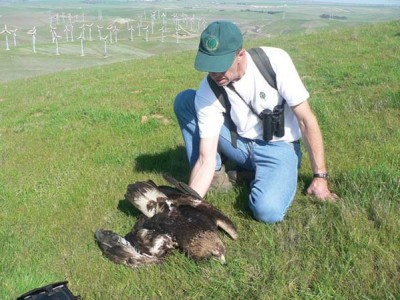 “Cumulative effects are practically never discussed by wind developers,” Newstead said. “At the end of the day, the most important numbers, for the sake of the wildlife, is how many of what species of birds and bats are being not only killed, but displaced.”
“Cumulative effects are practically never discussed by wind developers,” Newstead said. “At the end of the day, the most important numbers, for the sake of the wildlife, is how many of what species of birds and bats are being not only killed, but displaced.”
Newstead is one of most vocal challengers to the construction of wind farms along the Texas Coast and was part of an unsuccessful lawsuit to stop them, funded in large part by the King Ranch, which borders the Kenedy Ranch.
“There is no other place in North America that plays such an important role for so many species during some part of their lives,” Newstead said about the Laguna Madre and surrounding grasslands. “Collision mortality can thus affect any of more than 400 regularly occurring species.”
Newstead’s concerns for the coast only grow as more turbines are built, following the lead of the Kenedy Ranch.
Since the Kenedy turbines came online in 2009, Iberdrola has added more, and the Papalote Creek Wind Farm with 196 units was built outside Corpus Christi, according to AWEA.
When operating at capacity, the Kenedy Ranch turbines in total can generate close to 680 megawatts, or enough electricity to meet the needs of 135,000 to 170,000 homes, according to CPS Energy, which buys power from Iberdrola.
That power is produced during the day when consumer demand is the highest, and it can be delivered via uncongested transmissions lines, said CPS Energy spokeswoman Lisa Lewis, adding that effect on wildlife was not considered when it signed the contract.
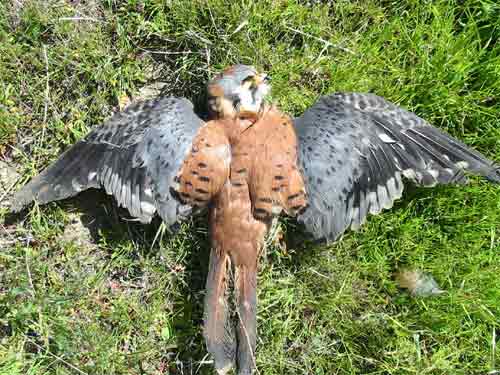
Working with wind
For now, wind companies face few consequences for killing wildlife, explained Paul Schmidt, assistant director at the Migratory Bird Program for the U.S. Fish and Wildlife Service.
While it’s against federal law to kill or harm any endangered, threatened or migratory bird species, the agency has not prosecuted any wind farm owner.
Instead, the service is working with the wind industry, scientists and conservationists to establish guidelines for how wind companies should place and operate a wind farm, Schmidt said.
A draft of those guidelines was released for comment this month.
Once the guidelines are adopted, the Fish and Wildlife Service will have a basis to decide which companies to investigate, Schmidt said.
“It’s just like you’re driving down the highway and the speed limit is 55,” he said. “You can go 60, probably 62, but at some point you are going to get caught.”
Schmidt said companies that volunteer information will avoid the scrutiny given those that do not.
Pattern and Iberdrola have regular communication with the service. But the reports they send are marked “privileged and confidential,” so they can’t be shared.
When Pattern gave its reports to the San Antonio Express-News, it called them public but then requested it preapprove anyone who saw them and that they not be posted online.
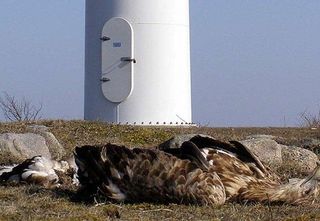 “Clearly we have a problem with transparency with the wind and wildlife issues, and I think we have a ways to go,” said Edward Arnett, director of programs at Bat Conservation International, whom Pattern approved to review its studies.
“Clearly we have a problem with transparency with the wind and wildlife issues, and I think we have a ways to go,” said Edward Arnett, director of programs at Bat Conservation International, whom Pattern approved to review its studies.
With wind farms across the country reluctant to share data openly, the understanding of the cumulative effect on wildlife and the best way to minimize it are stunted, Arnett said. This is especially true of bats.
At 150 feet long, the wind turbine blades move between 100 and 180 mph at their tip. The pressure change on the trailing edge is enough to cause internal hemorrhaging in bats, according to Bat Conservation International.
Before the Kenedy wind turbines went in, Arnett had expected low bat mortality, as there were no known concentrations of bats in the area. Since so little is known about bat movements, he is not surprised the numbers turned out to be higher.
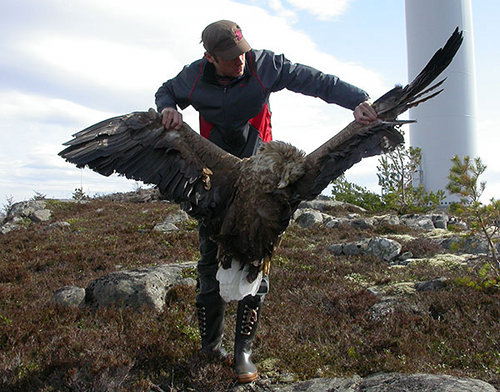 Before wind turbines were built, little was known about bat movements.
Before wind turbines were built, little was known about bat movements.
It isn’t possible to know what is and isn’t working, he said.
“Until we have the information published in a credible fashion that is publicly shared and published in journals, it is going to be unknown,” he said.
SECOND FEATURE:WIND TURBINE SHADOW FLICKER MAKES DANES MISERABLE
THIRD FEATURE
WIND TURBINE SHADOW FLICKER MAKES BADGERS MISERABLE
2/10/11 What's the latest from the Capitol? What happened at the hearing on the PSC's wind siting rules? AND Big Wind VS Little Birds. Guess who wins? Want to do something about it?
Click on the image above to see what an industrial wind project looks like after the sun goes down. People are often surprised to find out that all of the lights blink in unison. Why? These are FAA lights and red lights blinking in unison are the best way to get a pilot's attention. Red lights in the entire wind project area, which is sometimes thousands of acres, flash on and off all night long to keep aircraft from colliding with turbine blades.
Click on the image above to hear noise from the closest turbine to the home of Larry Wunsch who lives in the Invenergy wind project near the Town of Byron in Fond du Lac County.
This noise is the reason the Wunsch family decided to sell their home. However, after two years they've had no offers. Wunsch says that buyers who come to see the house don't even make it up the driveway. They turn around once they see the turbines surrounding his home.
This video was recorded from the front door of the Wunsch home with a video camera microphone not suited for noise such as this, nevertheless, the pulsing character of wind turbine noise is clear.
Larry Wunsch is a fire fighter and served on the Wind Siting Council. He testified at the Capitol yesterday, asking for a suspension of the PSC wind siting rules because they are not protective enough. Wunsch testified that while on the Wind Siting Council, he wanted to play his recording of turbine noise to help council members understand the problem but he was not allowed to do so.
Below, video of shadow flicker in another Fond du Lac county home at 6:30 AM
Above, shadow flicker in homes located in the Invenergy Forward Energy project, filmed by resident Gerry Meyer who also testified at the Capitol hearing.
WIND SITING RULES GET CAPITOL HEARING
Source: Wisconsin Radio Network
February 10, 2010
By Bob Hague
Lawmakers weighed the balance of wind energy in Wisconsin at the Capitol on Wednesday, with developers of wind turbine farms pitted against property owners and local governments who argue the massive turbines decrease property values and cause health problems.
Governor Scott Walker had proposed a special session bill which would have increased the setback for wind turbines from 1250 feet from a property line, to 1850 feet. That bill failed to advance, so now the Joint Committee on Administrative Rules is taking second look at the Public Service Commission rules which are scheduled to go into effect next month.
As the day long hearing got underway, committee members commented on the lengthy process of public hearings held by the PSC as the rules were being developed.
“I know it was a difficult task,” said Representative Dan Meyer (R-Eagle River). “But I have a feeling a lot of these people feel this is just going to be rammed down their throat. They may not want windmills in their backyard, but there going to get them, because the state of Wisconsin says ‘you’re going to have them.’”
State Senator Lena Tayler (D-Milwaukee) responded to Meyer’s comment. “There isn’t ramming going on here . . . 2009 to now is not ramming.”
Larry Wunsch is a landowner near Brownsville in south Fond du Lac county. Wunsch told the Joint Committee on Administrative Rules that a wind
farm near his property – and a turbine 1250 feet from his home – have changed his life. “When you put a device so close to my land that it drives me out of my property, I do have a say on that,” Wunsch told committee members. “We should be protecting Wisconsinites here.
Wunsch, who served on the Public Service Commission’s Wind Siting Council and signed onto its Minority Report, said he’s been unable to sell his property. Wunsch testified against the rules with another member of the Wind Siting Council who signed the Minority Report, Doug Zweizig from the Town of Union in Rock County. “The rules as written will not protect the health safety and welfare of impacted Wisconsin residents and communities,” said Zweizig, who serves on the Union Town Board, which had written its own ordinance on wind siting. Those impacts include sleep deprivation for a significant percentage of people living near turbines, according to Green Bay physician, Dr. Herb Cousins. “We make outstanding guidelines and rules for peanut allergies in school, when less than one percent or so of the population is affected by that,” Cousins said. “In this circumstance, up to fifty percent or more at this 1200 foot range will be affected.”
But Jeff Anthony with the American Wind Energy Association said if lawmakers decide to suspend the PSC rules, they’ll throw wind development projects around the state into chaos – and cost Wisconsin jobs. “The $1.8 million of investment in future wind projects that are currently on the books and planned for Wisconsin, will not happen. Two million construction job hours to build those projects, will not happen in this state,” said Anthony. “Farther down the road, you could have an impact on the manufacturing sector.”
The rules were drafted as a response to an uncertain landscape for wind development in Wisconsin, as local governments such as Doug Zweizig’s town board drafted their own – sometimes restrictive – wind siting ordinances. But Bob Welch, a former state lawmaker who now lobbies on behalf of a coalition of opponents, said the PSC rules go too far. “What the PSC rules want to do is say ‘you don’t get to decide what goes in your community. You have nothing, absolutely nothing to say about it’ if these rules are in place. They’re going to decide what goes in your community, not you. I don’t think that’s the Wisconsin way.”
Landowners who have wind turbines sited within a half mile of their property lines are eligible for ‘good neighbor’ payments. But apparently not all are interested in getting the money. “I have two of them within that parameter, so I would make a thousand dollars a year,” Larry Wunsch told the committee. “Personally I think it’s dirty money, it’s bribe money and I’ve never taken it, I don’t plan to take it. If they want to make it right with me, buy my house. Let me get out of there.”
AUDIO: Larry Wunsch, Doug Zweizig (7:00)
PSCs Final Wind Siting Council Report (PDF)
Click on the images below to watch short videos of the Wind Siting Council in action
WISCONSIN RULE ON TURBINE BUFFERS HIT CLOSE TO HOME FOR SOME
February 10, 2011
By Andrew Averill
A legislative joint committee heard over nine hours of passionate testimony Wednesday from several hundred citizens and wind energy developers on a rule that would standardize the buffer distance between a wind turbine and surrounding structures across the state.
The Joint Committee for Review of Administrative Rules heard testimony on a wind siting rule proposed by the Public Services Commission. The rule specifies the restrictions a city, village, town or county could impose on wind energy systems. While wind developers mainly agreed with the PSC, a large portion of citizen testifiers opposed the rules, Sen. Fred Risser, D-Madison, said.
“The majority of [testifiers] I’d say were people who didn’t want the rules,” Risser said. “When you get down to it, they didn’t want windmills.”
The rule would require turbine setback distances for non-participatory properties to equal three times the maximum length of the turbine blade. Turbines only have to be one blade length away from the property hosting it.
Most citizens testified the distances are not far enough away and have caused unwanted effects.
Joan Lagerman from Malone, located on the east side of Lake Winnebago, told the committee she had stories that realized the fears other testifiers brought up. Her son, an otherwise healthy 17-year-old, recorded systolic blood pressure as high as 160, which she attributes to the turbine near her house, she said.
Another man with three turbines near his property recalled coming home to take care of his wife who was sick with the flu. He returned at night expecting his wife to be resting in bed, but saw her writhing on the floor in the middle of the hallway squeezing blankets and pillows against her ears trying to dampen the sound from the turbines.
Other opponents of the rule spoke of developer’s “time-share hustling” property owners with 28-page contracts, persistent radio interference, deteriorating health of farm animals due to stray voltage and constant low frequency humming.
Hearing loss can occur with noise levels over 85 decibels, according to a National Institute for Occupational Safety and Health study. The PSC rule requires turbines to be no louder than 50 db, but one citizen in Fond du Lac County said he measured the turbine at a constant 63 db.
However direct the citizen testimony, Risser said the question the committee must ask in deciding whether to uphold, modify or suspend the PSC’s rule is what is best for the state, and there are people who feel very strongly the state should pursue wind energy and the jobs it would provide Wisconsin.
Chris Deschane, speaking on behalf of wind developer Michels Corporation located an hour northeast of Madison in Fond du Lac, said he supported the PSC rule and elaborated on the jobs that Michels could create if the committee voted in favor of the rule.
“For each 100 megawatts in Wisconsin, it will generate 125 immediate jobs that last for one or two years and several dozen recurring jobs,” Deschane said. “Each of these jobs are well compensated and we provide exceptional health benefits.”
Another developer, David Vander Leest of Prelude LLC Wind Farms, said if the rule is not passed and the setback distance between a wind turbine and the nearest structure is increased as a result, Wisconsin might as well give the wind industry of “time of death.”
Although Risser said both developers and citizens gave strong arguments, he suspects the committee would vote to suspend the rule sometime before March 1, when the rule would begin to take effect.
BIRD DEATHS FROM WIND FARMS TO CONTINUE UNDER NEW FEDERAL VOLUNTARY INDUSTRY GUIDELINES
SOURCE: American Bird Conservancy
February 10, 2011
(Washington, D.C.) Draft voluntary federal guidelines issued today by the Interior Department that focus on the wildlife impacts of wind energy will result in continued increases in bird deaths and habitat loss from wind farms across the country, says American Bird Conservancy (ABC), the nation’s leading bird conservation organization. Members of the public will have 90 days to provide comments on the proposed guidelines to the Secretary of the Interior prior to a final version being concluded.
“We had hoped that at the end of this multi-year, Interior Department process, we would see mandatory regulations that would provide a reasonable measure of restraint and control on a potentially very green energy source, but instead we get voluntary guidelines,” said ABC Vice-President Mike Parr.
“Bird deaths from wind power are the new inconvenient truth. The total number of birds killed and the amount of bird habitat lost will dramatically increase as wind power build-out continues across the country in a rush to meet federal renewable energy targets,” Parr said.
“We fast-tracked dams in the first half of the last century at the expense of America’s rivers. Now we’re having to tear many of them down. Let’s not fast track wind energy at the expense of America’s birds. Just a few small changes need to be made to make wind bird-smart, but without these, wind power simply can’t be considered a green technology” Parr said.
“This action did not have to result in voluntary guidelines. DOI has the authority under the Migratory Bird Treaty Act to enact regulations protecting migratory birds. Further, it is troubling that this announcement was made without the final documents being available that would enable a review of exactly what is being proposed,” Parr said.
Some of the most iconic and vulnerable American birds are at risk from wind industry expansion unless this expansion is carefully planned and implemented. Onshore, these include Golden Eagles, Whooping Cranes, sage-grouse, prairie-chickens, and many migratory songbirds. Offshore, Brown Pelicans, Northern Gannets, sea ducks, loons, and terns are among the birds at risk.
“Federal government estimates indicate that 22,000 wind turbines in operation in 2009 were killing 440,000 birds per year. We are very concerned that with Federal plans to produce 20 percent of the nation’s electricity from wind by 2030, those numbers will mushroom. To meet the 2030 goal, the nation will need to produce about 12 times more wind energy than in 2009.” he added.
“The guidelines ask the wind industry to do the right things, but there is no reason to believe that any will happen with any consistency. The poster child for the wind industry’s environmental track record is the Altamont Pass Wind Farm in California. Despite years of concern voiced by many in the wildlife community about large numbers of eagles and other raptors being killed at Altamont, it took a lawsuit to get the industry to respond,” Parr said.
“Birds continue to be killed at Altamont and other wind farms in violation of the Migratory Bird Treaty Act,” he added.
American Bird Conservancy supports wind power when it is bird-smart, and believes that birds and wind power can co-exist if the industry is held to mandatory standards that protect birds. ABC has established a petition for concerned members of the public to lend their support to the campaign for bird-smart wind.
Onshore bird-smart wind power implements siting considerations, operational and construction mitigation, bird monitoring, and compensation, to redress unavoidable bird mortality and habitat loss. Although offshore wind power is not yet operational in the U.S., an analogous set of siting, operating, and compensatory measures needs to be developed to make it bird-smart.
All wind farms should have an Avian Protection Plan that includes ABC’s bird-smart principles and a means of implementing it and tracking and reporting on its implementation. Wind farms should also comply with relevant state and federal wildlife protection laws such as the Endangered Species Act, Migratory Bird Treaty Act, Bald and Golden Eagle Protection Act, and National Environmental Policy Act.
NOTE: American Bird Conservancy conserves native birds and their habitats throughout the Americas by safeguarding the rarest species, protecting and restoring habitats, and reducing threats while building capacity of the bird conservation movement. For moreinformation, visit, www.abcbirds.org
12/20/10 Radio Radio: Listen to wind rules discussed on WORT'S 'A Public Affair' AND! This Just In: Yet another letter from legislators to Senator Plale asking him to object to the wind rules BUT Is there a mailbox in his spider hole?
EXTRA CREDIT READING:
CLICK HERE for Clean Wisconsin's 2009 testimony to the Public Service Commission during the Glacier Hills Wind Project hearings--Clean Wisconsin tells the PSC there will no CO2 reduction because of the implementation of the Glacier Hills project unless the PSC also requires a coal fired plant to be shut down.
Result: The PSC approves the project with no requirement that a coal-fired plant to be shut down.
12/7/09 Clean Wisconsin lives up to its name by taking on the dirty elephant in the room.
December 16, 2010
Dear Senator Plale and Representative Soletski,
We are writing to express our concerns regarding Clearinghouse Rule 10-057 which sets state-wide standards for the siting of wind towers.
The Rule pending before your committee should be sent back to the Public Service Commission for modifications.
We appreciate the work of both committees on this proposed rule. Much of the citizen reaction, including that of your constituents raised serious concerns about the effects of the rule. We are grateful for the committee action in October to return the rule to the PSC for modifications.
Unfortunately, the PSC modified Rule sent back to your committee this month does not address the concerns expressed by citizens of members of your committee.
Specifically, we are deeply concerned about the setback provisions and its effect on neighbors to properties containing wind towers. Substantial testimony was provided by citizens describing this setback as completely unacceptable.
It seems the PSC has entirely disregarded the will of Wisconsin's citizens and elected officials.
We respectfully urge you to consider the will of the people and those whom they have elected. We ask the committee to either return the rule to the PSC for further modifications or act quickly to object to the proposed rule so it can be taken up the Joint Committee on Review of Administrative Rules.
Thank you for your attention to this matter,
Sincerely,
Kathleen Vinehout
State Senator
31st Senate District
Chris Danou
State Representative
91st Assembly District

